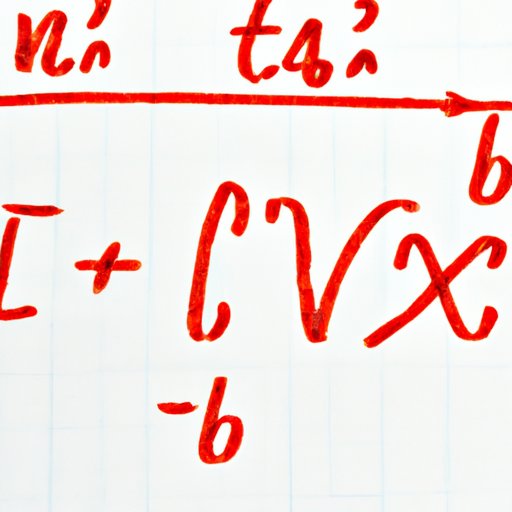
Introduction
Solving an equation can sometimes be challenging, but it becomes even more so when you don’t know how many possible solutions exist. It’s crucial to understand the number of solutions before making any conclusions because this impacts the outcome. This article will provide a step-by-step guide to help you understand how to determine the number of solutions an equation has, including various techniques, real-life examples, and a few puzzle analogies.
Step-by-step guide for solving equations
When solving an equation, one needs to follow a particular procedure. We will use an invented equation:
2x + 5 = 9
To solve the equation:
1. Begin by isolating the variable (x); in this case, by subtracting five from each side:
2x + 5 – 5 = 9 – 5
2x = 4
2. Divide both sides of the equation by the coefficient of the variable to isolate the variable (x):
2x/2 = 4/2
x = 2
You’ve now discovered the solution to this equation, which is x = 2. Although there is only one answer in this case, it’s not always that simple. The number of solutions can vary depending on the input of the equation, and we’ll discuss this next.
The number of solutions
Another essential aspect to consider is the number of solutions. Depending on the equation, there can be none, one, or several solutions. Differentiate the number of equations:
1. No Solution: These are equations that have no possible solutions. For example, the equation:
x + 3 = x + 6
There are no solutions because if you subtract ‘x’ from both sides, then 3 = 6, which is impossible.
2. One Solution: These are the equations that have a single solution. For example, the equation:
2x + 5 = 9
The solution is x = 2.
3. Many Solutions: These are equations that have multiple solutions, for example:
x^2 = 16
This equation has two possible solutions:
x = 4 or x = -4
To solve an equation successfully, you’ll need to combine all the techniques and steps we’ve addressed so far. Next, let’s discuss a graphical representation that can help determine the number of solutions.
Graphical representation
Creating a graph of the equation is one of the easiest ways to determine its characteristics. The graph provides a visual representation of the equation, allowing you to identify aspects such as intercepts, slopes, and curvature that can impact the possible solutions.
Let’s use the equation:
x^2 – 4x + 3 = 0
To visualize the equation, begin by converting the left side to the graph’s formula:
y = x^2 – 4x + 3
Then plot the coordinates using an x-y graph:

The solutions to the equation are where the graph intersects the x-axis, i.e., where the y-value equals zero. In this case, there are two solutions, x = 1, and x = 3.
Analogy
Solving equations may sometimes look like solving puzzles. Puzzle-solving can make the problem simpler and more enjoyable. Here are a few examples:
Imagine that you had a grid with different colors, and you were supposed to paint all the blocks red. If you used a paintbrush that was twice the size of the blocks, you would need to use fewer strokes, but the color wouldn’t be as vibrant as it would be if you used a smaller brush. This would relate to the idea of solving an equation with one or more solutions. Sometimes you can make it more simply, but the result isn’t as accurate as it could be.
Another analogy could be that of a crossword puzzle. If you don’t have all the letters correct, then you won’t be able to complete the puzzle. In the same way, if you don’t have all the right information to solve the equation, you’ll not find the solution.
Real-life applications
The principles that we have explained so far aren’t just limited to a mathematical context, for instance:
1. In Physics, equations for calculating speed, distance, and time have to be solved to measure and predict the movement of particles.
2. Engineers use equations to design buildings or bridges that are structurally stable.
3. Financial analysts use equations in calculations for various statistical models.
These examples demonstrate that equations and their solutions have practical applications that are essential to people working in these industries. Understanding the correct number of solutions is imperative to achieving accurate results.
Examples
There’s no better way to learn anything than practicing it. We’ve put together a series of examples to help you gain experience in solving equations of varying degrees of difficulty and solutions:
1. x^2 – 2x = 1
2. 5x – 9 = – 4x + 5
3. 4x + 2 = 10
4. 4x^2 – 9 = 0
5. 10x^2 – 7x + 1 = 0
To solve these equations, follow the steps we outlined earlier.
Interactive tool
Practice makes perfect, so we’ve included an interactive tool below that you can use to enter an equation and, in real-time, get an answer! This tool will also show you how to solve the equation and the specific number of solutions. Try it out!
Conclusion
Solving an equation can be an intimidating process, but it becomes more manageable when you understand the number of solutions it has. We’ve covered the essential aspects that you’ll need to consider when solving equations: understanding the correct steps to follow, the number of solutions, creating graphs, analogies, real-life applications, examples, and an interactive calculator.




